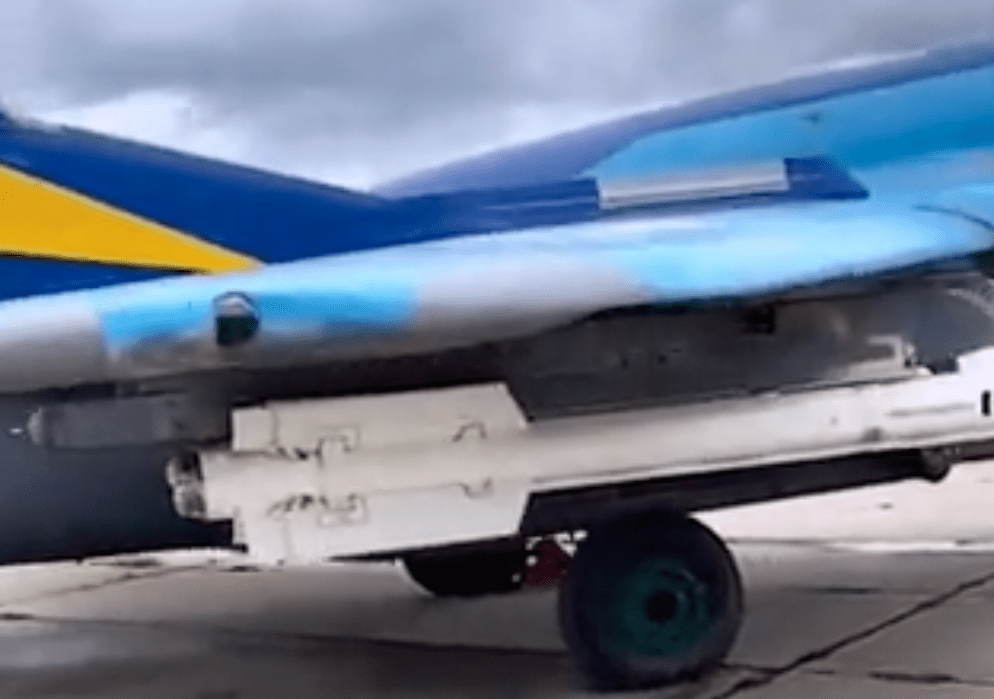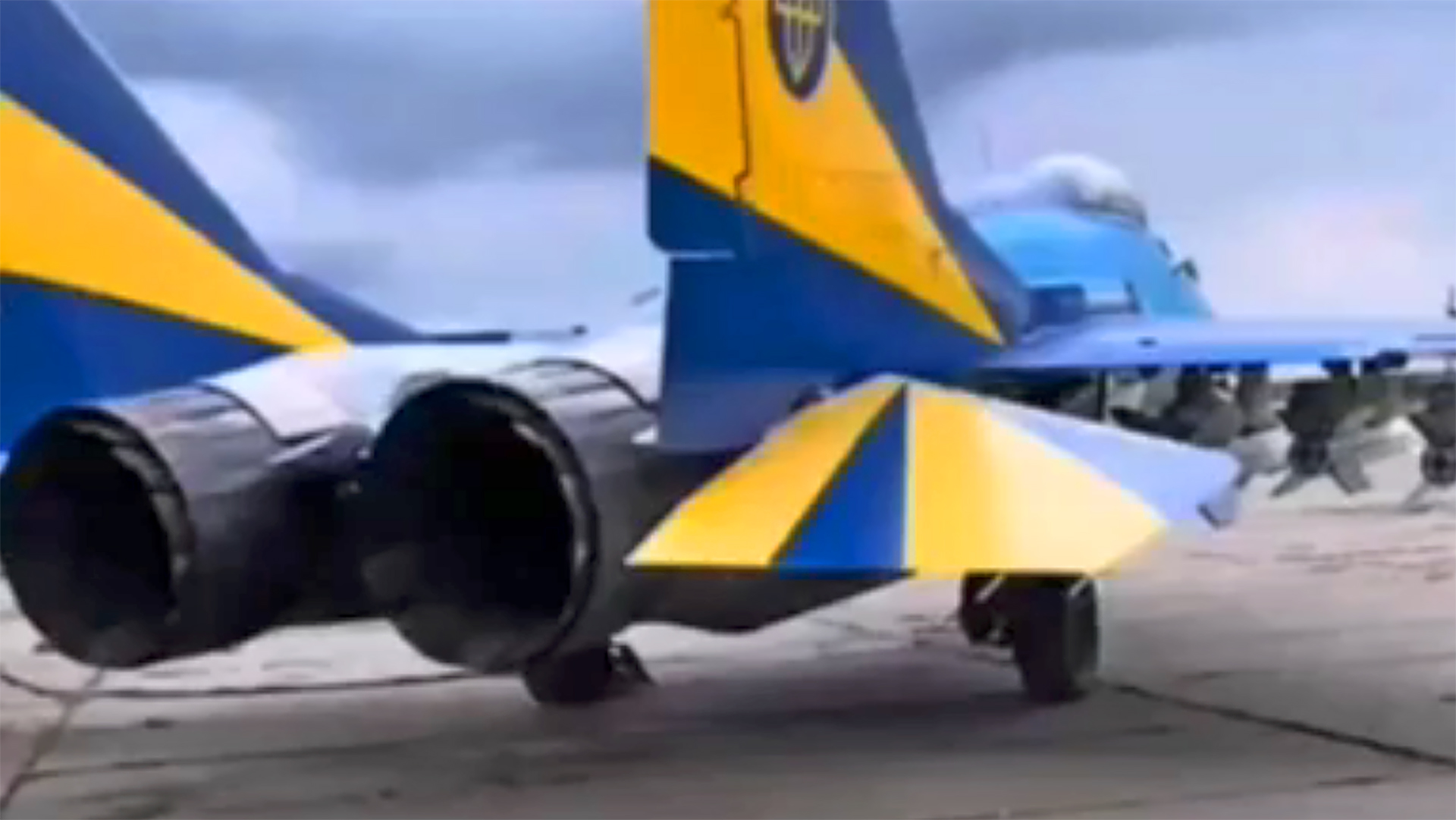A number of recent reports have suggested that the Ukrainian Air Force is now flying a colorfully painted MiG-29 Fulcrum fighter jet formerly flown by the country’s aerobatic display team on combat missions against Russia. Inspired by the appearance of a MiG-29 wearing a color scheme similar to that used by the now-defunct Ukrainian Falcons team, these accounts claim that at least one of the famous unit’s jets has been returned to service, helping meet an urgent demand for fighters. The truth is a little more complex, as serving Ukrainian Air Force MiG-29 pilot ‘Juice’ explained to The War Zone.
The single-seat MiG-29 seen in the video in question, now widely shared on social media, does indeed wear a blue and yellow paint scheme that bears some similarities to those that were applied to the jets flown by the Ukrainian Falcons. Compared with the two different schemes used by the Ukrainian Falcons, however, the jet in the video looks significantly different, with none of the large areas of white on the fuselage, the red cheatline, or titles.

The fighter is also seen with apparently live infrared-guided R-73 (AA-11 Archer) and radar-guided R-27R (AA-10 Alamo) air-to-air missiles under its right wing, indicating that it’s combat-capable. The video cuts short before showing the forward fuselage of the jet, so it’s not possible to see the individual code number.

However, according to Juice, the Fulcrum is an “absolutely usual combat MiG,” which was simply painted in these colors after undergoing repairs. As such, the jet is part of the frontline fleet and has apparently been used in combat, but its livery does not confirm that it came from Ukrainian Falcons stocks. Indeed, Juice said that reports that the MiG is “an old aerobatic fighter jet” are “bullshit.”

Instead, it seems the patriotic paintwork was added essentially as a morale booster, reflecting the continued ability of the air force to fight against overwhelming odds, and of the local maintenance, repair, and overhaul facilities to keep the MiGs serviceable, even when facing Russian attacks.
Juice also explained that the jet in question had been refurbished after a long period spent grounded. Whether that process was aided by the provision of spare parts from foreign sources, that’s less clear, although we have approached the Ukrainian Air Force for comment. It’s certainly a possibility since U.S. officials confirmed in April that Washington had facilitated deliveries of spare parts for the fighters, perhaps from Poland and even the United States.
Speaking on April 19, Pentagon Press Secretary John F. Kirby noted that the Ukrainian Air Force had “more operable fighter aircraft … than they had two weeks ago.” This suggests that the newly arrived spare parts have been used to bring previously dormant jets back to life, as well as help sustain the MiGs that had been active at the start of the invasion.
It may well be the case that these spares helped Ukraine reactivate the aircraft in the video, although we don’t know that for sure. However, with at least six independently verified MiG-29 losses, and likely many more beyond those, any such additions to the fleet are going to be highly prized.
The MiG-29, and the pilots that fly it, have, more generally, become something of a symbol of Ukrainian resistance since the early days of the war, when the story of the so-called Ghost of Kyiv began to get plenty of traction. You can read all about that phenomenon here. Alongside a smaller number of Su-27 Flankers, the MiG-29 continues to bear the brunt of the air defense missions, as well as periodically undertaking offensive duties.
It’s more than likely that the facility that painted the jet in Ukrainian Falcons-inspired colors was also hoping to leverage some of that team’s former fame in the service of the propaganda war. While the Ukrainian Falcons only existed as a team between 1996 and 2002, they made a significant impression during their tenure, which included a high-profile performance at the Royal International Air Tattoo in the United Kingdom.

Most of the team’s jets ultimately went into storage at Kirovske in Crimea. At least one was returned to service in 2012, receiving a new ‘digital’ paint scheme as it was refurbished.
Since then, there have been at least two efforts to reestablish the team, in 2008 and 2012, but financial constraints and the demands of the war in the east of the country, which really began in 2014, have put stop to this. Juice also notes that several frontline MiGs were also painted in ‘Pseudo Falcons’ colors for an independence parade appearance in 2009. Other ‘Pseudo Falcons’ appeared after that date, again with no direct relationship to the original aerobatic team.

Subsequently, at least one specially painted and fully armed MiG-29 was noted in action over the eastern Donbas region in 2014, apparently conducting a show of force over Russian separatists, as seen below.

The fortunes of the jets stored in Crimea took a dramatic turn when Moscow’s forces captured Kirovske in 2014, during which the MiGs were used to block the runway to prevent Russian access. Somewhat surprisingly, however, the Russians allowed Ukraine to keep the jets, which were transported by road to Kulbakino in May of the same year. Seven former Ukrainian Falcons jets were reportedly among those that were moved.
Beginning in 2015, MiGs recovered from Crimea began to be modestly upgraded to MiG-29MU1 standard by the facility in Lviv. Since 2018, at least three such former Ukrainian Falcons jets were returned to service. These also all received the new-look digital color scheme, too.
Once again, there is no evidence that the jet seen in the recent video is anything other than a standard Ukrainian Air Force MiG-29 that’s been returned to service, albeit with a decidedly non-standard color scheme. Since the jet is intended to undertake combat duties, the choice of such a conspicuous livery is questionable, but it seems that the morale-boosting value was judged to be more important, for now at least.
And, in the absence of transfers of more MiG-29s, or other fighters, and as aircraft losses to Russia continue to mount, it’s not hard to understand why the Ukrainian Air Force might need that kind of boost right now.
Contact the author: thomas@thedrive.com
